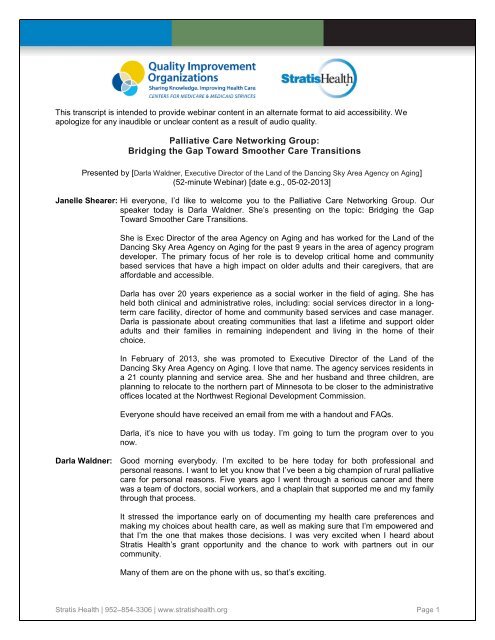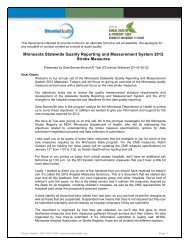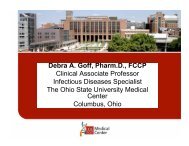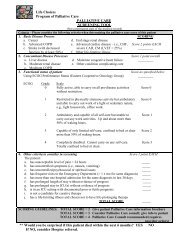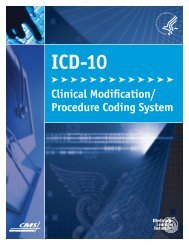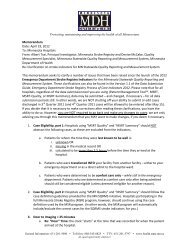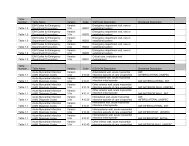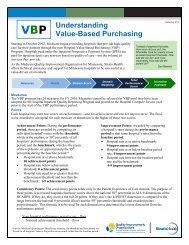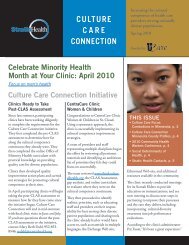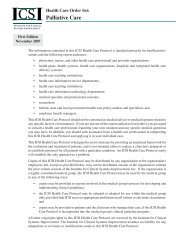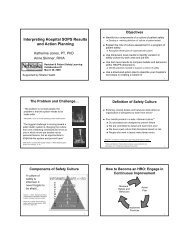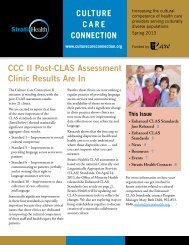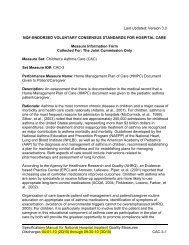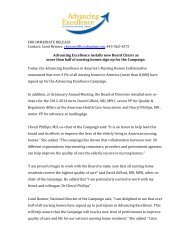Webinar Transcript Template - Stratis Health
Webinar Transcript Template - Stratis Health
Webinar Transcript Template - Stratis Health
Create successful ePaper yourself
Turn your PDF publications into a flip-book with our unique Google optimized e-Paper software.
This transcript is intended to provide webinar content in an alternate format to aid accessibility. We<br />
apologize for any inaudible or unclear content as a result of audio quality.<br />
Palliative Care Networking Group:<br />
Bridging the Gap Toward Smoother Care Transitions<br />
Presented by [Darla Waldner, Executive Director of the Land of the Dancing Sky Area Agency on Aging]<br />
(52-minute <strong>Webinar</strong>) [date e.g., 05-02-2013]<br />
Janelle Shearer: Hi everyone, I’d like to welcome you to the Palliative Care Networking Group. Our<br />
speaker today is Darla Waldner. She’s presenting on the topic: Bridging the Gap<br />
Toward Smoother Care Transitions.<br />
She is Exec Director of the area Agency on Aging and has worked for the Land of the<br />
Dancing Sky Area Agency on Aging for the past 9 years in the area of agency program<br />
developer. The primary focus of her role is to develop critical home and community<br />
based services that have a high impact on older adults and their caregivers, that are<br />
affordable and accessible.<br />
Darla has over 20 years experience as a social worker in the field of aging. She has<br />
held both clinical and administrative roles, including: social services director in a longterm<br />
care facility, director of home and community based services and case manager.<br />
Darla is passionate about creating communities that last a lifetime and support older<br />
adults and their families in remaining independent and living in the home of their<br />
choice.<br />
In February of 2013, she was promoted to Executive Director of the Land of the<br />
Dancing Sky Area Agency on Aging. I love that name. The agency services residents in<br />
a 21 county planning and service area. She and her husband and three children, are<br />
planning to relocate to the northern part of Minnesota to be closer to the administrative<br />
offices located at the Northwest Regional Development Commission.<br />
Everyone should have received an email from me with a handout and FAQs.<br />
Darla, it’s nice to have you with us today. I’m going to turn the program over to you<br />
now.<br />
Darla Waldner: Good morning everybody. I’m excited to be here today for both professional and<br />
personal reasons. I want to let you know that I’ve been a big champion of rural palliative<br />
care for personal reasons. Five years ago I went through a serious cancer and there<br />
was a team of doctors, social workers, and a chaplain that supported me and my family<br />
through that process.<br />
It stressed the importance early on of documenting my health care preferences and<br />
making my choices about health care, as well as making sure that I’m empowered and<br />
that I’m the one that makes those decisions. I was very excited when I heard about<br />
<strong>Stratis</strong> <strong>Health</strong>’s grant opportunity and the chance to work with partners out in our<br />
community.<br />
Many of them are on the phone with us, so that’s exciting.<br />
<strong>Stratis</strong> <strong>Health</strong> | 952–854-3306 | www.stratishealth.org Page 1
For professional reasons, at the Land of the Dancing Sky and with my counterparts<br />
across the state, what we’ve all been trying to accomplish in the field of health care is<br />
designing a system that supports older adults in our case and young adults as well. But<br />
for older adults living independently in their home and giving them tools to be able to<br />
manage the illness and age in place.<br />
We can’t do that alone, so we learned early on that collaboration is a successful model<br />
for being able to provide that safety network.<br />
The Land of the Dancing Sky has 21 counties and we’re all in the northwest side of<br />
Minnesota. It’s 385 sq. miles in that service area and sometimes that’s a daunting task.<br />
We talk about rural palliative care in our 21 counties, all of them with the exception of<br />
the community of Moorhead, according to the state demographic society are<br />
considered rural. So this really speaks to our language.<br />
We talk about bridging the gap for older adults. We talk about putting that safety net<br />
around them and before we do that we have to understand some of the demographics<br />
in our state and together how can we accomplish that task.<br />
I’m sure many of you are aware of the silver tsunami statistics or the dot in the age<br />
wave that is facing many of our communities. The reality is that between 2005 and<br />
2035, people 55+ will double from 600k to 1.3 million older adults in our state. Eightyfive<br />
plus population will nearly double to 163k, and what do we know about that? As<br />
older adults age, their disease progresses and that impacts all of us in this room and<br />
our impacts our ability to provide for those diverse needs.<br />
By 2020 there will be more people 65+ than school age children. What does that say<br />
about the amount of caregivers that will be available to meet these needs?<br />
The next slide is a good visual about the growth we’ve seen in the 85+ population,<br />
starting in 1990 when we were below the 80k mark and slowly going towards the top. It<br />
basically says that we’ll be overwhelmed by this population and that we need to be<br />
ready as communities to serve them.<br />
Income diminishes as one ages, which puts yet another stressor on the system. The<br />
poverty rate for 65+ is 8.3% in the state of Minnesota and a poverty rate for 75+<br />
increases to 10.3%. Elders of color have a higher poverty rate. What’s known as a<br />
staging for older adults in the state of Minnesota is the medical assistance program.<br />
Currently the program serves the long-term care needs of just over 5% of Minnesota<br />
seniors, a relatively small population.<br />
Minnesota’s relatively modest medium income level results in a large number of older<br />
adults, who will need support outside that safety net. Because of the impact that a small<br />
percentage of seniors will be eligible for medical assistance, will be critical for us to<br />
build bridges so these people are able to cross multiple health care settings with<br />
pathways that can be created through rural palliative care and bridge through senior<br />
linkage line and the areas agency on aging as well as other home and community<br />
based partners.<br />
One of the key roles that the Area Agency on Aging plays is in the area of development<br />
of home and community based partners that are critical access services.<br />
What do we know? We know the vast majority of long-term care starts at home.<br />
Minnesota has had a strong network of service providers that deliver low cost, high<br />
impact services, chores, homemakers, grocery shopping, meals and transportation are<br />
all just examples of that.<br />
The thing I love about working with our rural partners is that collaboration isn’t<br />
something that’s new to us.<br />
<strong>Stratis</strong> <strong>Health</strong> | 952–854-3306 | www.stratishealth.org Page 2
The foundation of all the organizations we work with were built on the successful model<br />
of collaboration, so I feel it’s a skillset we’ve been born into. Other things we need to be<br />
aware of within the field of home and community based services I can’t stress the<br />
importance enough that we can’t do this without the family and friends providing<br />
assistance to older adults.<br />
Even a 1% reduction in family assistance equates to $30 million increases in the state<br />
budget. That’s huge, that’s not small change. Increasing the supply and the types of<br />
caregiver support services and activating informal networks is critical. At the areas<br />
agency on aging we have taken a strong role in the area of caregiver services and we<br />
provide funding for several programs as well as caregiver coaching. A lot of care giving<br />
isn’t just a six month span of life, it can be a long journey and we know that often<br />
caregivers end up becoming sicker than the folks they’re caring for.<br />
So it’s critical to have this caregiver coaching program that can walk hand-in-hand with<br />
them. Sometimes they aren’t ready to have care because coming into their homes<br />
seems huge to them. So having the caregiver that can be a resource to them, support<br />
them and provide them with the tools to manage, this practice is critically important.<br />
Let’s talk about Area Agency on Aging elder care development partnership. When<br />
Janelle said I worked for the Area Agency on Aging for nine years it’s actually been in<br />
this role that I worked in prior to February of this year. It’s something I’ve been very<br />
passionate about. For the past 20 years the Area Agency on Aging partnership has<br />
played a critical role in developing home and community based options.<br />
The reality is that in rural northwest Minnesota and parts across our state, we don’t<br />
have multiple providers. We have providers, might be one wearing multiple hats,<br />
because that’s what they need to be in the community’s they serve. We’ve worked with<br />
many of our local partners to identify and develop the gap analysis process as well as<br />
needs assessments and what the things are that are lacking in those communities and<br />
pulling the partners together.<br />
We’re doing some pretty incredible things on $20k budgets in a lot of these<br />
organizations, which are very much volunteer driven and have a huge impact. They’re<br />
saving a lot of money, but most importantly all their adults are allowed to remain in their<br />
homes.<br />
One of the areas that we work with is with local aging resource centers. The Area<br />
Agency on Aging, that was created under the Older Americans Act, has a statewide<br />
home and community based network that develops and delivers non-medical services<br />
to help older adults remain in independence at their homes.<br />
When we talk about the designs of Minnesota’s aging network what we’re talking about<br />
is that it’s designated by the Minnesota Board on Aging. There are six regional area<br />
agencies on aging and one tribal Area Agency on Aging. Some of the roles they play<br />
are stewards of federal and state funds. They are experts on community services, care<br />
giving, volunteer support, housing options, Medicare and public benefits.<br />
More importantly, I can tell you that I know many of these individuals on a personal<br />
level and they truly care about the elder adults they’re serving. They help organizations<br />
for local vendor networks as well.<br />
Let’s discuss how the Areas Agency on Aging impact the care transition process. One<br />
of the areas that we can have an impact and have been successful in is consulting one<br />
to one with older adults and their families about services, housing choices, caregiver<br />
support, Medicare benefits and county services. That’s a daunting task but it’s providing<br />
them with long-term care option counseling that encompasses from finding someone to<br />
clean their home to helping them understand long-term care insurance.<br />
<strong>Stratis</strong> <strong>Health</strong> | 952–854-3306 | www.stratishealth.org Page 3
It helps older adults transition across care settings. We take a big role in advocacy in<br />
that area as well. Identifying needs and distribute federal and state resources to fund<br />
services for seniors and caregivers. In that role we are a grant administrator for Older<br />
Americans Act dollars that provide services to entities on a funding formula. Some of<br />
those services are in the community’s served so we fund Meals on Wheels, Caregiver<br />
and other services, homemaker chores, transportation programs, as well as legal<br />
services and evidence based programs such as a Matter of Balance and trying to be<br />
self managed in living with a chronic condition.<br />
We are also partnered to develop effective services and programs. A lot of what we’ve<br />
done under that umbrella is during these economic times everyone is getting cuts in<br />
funding that the high cost of inflation is impacting to many of these programs that are<br />
driving huge distances. Their travel time and mileage is no news, I’m speaking to the<br />
choir on this subject, it’s eating up budgets that are already thin.<br />
So a key role we’ve taken on is helping these organizations sustain themselves and<br />
helping them figure out what that pathway is beyond their walls and who needs to sit at<br />
their table so that together they can merge and address the issues.<br />
One of the things we’ve been most excited about as a state is our senior linkage line,<br />
which is a toll free information assistance line, a consultation by telephone, a web chat<br />
or at home. The computer systems and technology that they use for this is remarkable.<br />
They can do live chats, transfers when an older adult calls. It’s not like Medicare or<br />
Social Security where it’s push one button and you’re transferred with lovely elevator<br />
music and you’re on the line for 20 minutes, oops you were disconnected.<br />
That’s frustrating for me and I have adequate hearing and I’m very assertive with my<br />
needs, but imagine an older adult that can’t hear well and might be dealing with<br />
memory loss issues where trying to use a telephone system is huge. Through the<br />
linkage line they’re able to evaluate complex living situations, connect to housing<br />
options and services such as homemaker meals and transportation, medication<br />
management, home modification and wellness programs. They also answer Medicare<br />
and insurance questions.<br />
Some of the tools for older adults to figure out are on the web. What do we know about<br />
older adults? That the 85+ population very seldom even know how to turn a computer<br />
on, although we are making gains. I think the baby boomers will change that dynamic in<br />
our lives. A lot of those tools again are web based, so the senor linkage line is key and<br />
the good thing is that it’s unbiased so they aren’t linked to a financial source, they’re<br />
just helping them understand the sources that are available out there.<br />
Also, follow up is very much part of the senior linkage line. When an older adult or a<br />
family member accesses the line and go through the process of reviewing the options,<br />
there is follow up afterwards to make sure the process and their needs were met and<br />
see if there are any further needs to be met in the process.<br />
The senior linkage line was created for one stop for answers on aging. I can’t tell you<br />
how many times I sit across the table from older adults and they’re tired and worn out<br />
and we ask them their story and they say do you realize you’re the 8 th person this week<br />
I told my story to? How frustrating is that? They have to tell their story when they sign<br />
up for home health. They have to tell their story when they go to the physical therapist.<br />
They have to tell their story when the homemaker and chores services show up. This is<br />
their answer, one stop for answering on aging.<br />
It is the information assistance line, Monday through Friday 8:00 to 4:30 and yes I<br />
recognize that not all problems occur during those days and times, but the options are<br />
there and available.<br />
<strong>Stratis</strong> <strong>Health</strong> | 952–854-3306 | www.stratishealth.org Page 4
If you’d like more information on the Minnesota Area Agency’s on Aging I’m providing<br />
you with all the information, including all the AAA across our planning and service area.<br />
I also wanted to bring attention to the other handout we provided, which was developed<br />
by M4A as a service for seniors in-service network. In the boxes you can see some of<br />
the programs that are supported both informal and formal networks across the planning<br />
and service areas.<br />
This is actually a good tool and handout to give to older adults when they’re trying to<br />
understand the services that are there. I can’t stress enough the importance of the<br />
collaboration between the Area Agency on Aging and the palliative care networks. With<br />
the things that are going on in federal and state with healthcare home process and<br />
models as well as the hospitals with the readmission rates and some things that are<br />
going on with the projects across our states, it’s where the formal and informal<br />
healthcare systems have to come together and create a system that’s seamless for<br />
these older adults as they transition across healthcare settings.<br />
I know the Area Agency on Aging is a small piece of that pie but we feel it’s necessary<br />
to be at that table and help put these collaborations and bridges together.<br />
Let’s open up for questions…<br />
Janelle Shearer: I’ve heard of Meals on Wheels and Area Agency on Aging, but now that the regulation<br />
for hospitals to call the senior linkage line is when someone is at risk. It’s like a well<br />
kept secret.<br />
How does it really work and are these services free for people?<br />
I know Meals on Wheels isn’t because my parents had that and had to pay for their<br />
meals, but if you could tell us how it works for folks who need things.<br />
Darla Waldner: I agree it’s one of the best kept secrets, so that was a nice way of putting it. We receive<br />
referrals from multiple points of entry in the system and hospital and discharge planners<br />
are key referral sources for that. Now it’s even being mandated that that partnership be<br />
strengthened.<br />
How it works is that we have a wide variety of home and community based service<br />
providers, some of which are grantees of the Older Americans Act dollars that we fund<br />
through all our Area Agency on Aging. Some are partners that we provide technical<br />
assistance to through grant writing and community service development grants as well<br />
as private foundations and other local funding opportunities.<br />
Under the Older Americans Act, it’s based on people’s ability to pay and nobody is<br />
denied services, regardless of their ability to pay. We do emphasize with our community<br />
based partners that they provide the opportunity for older adults to share in their<br />
services and I think that’s something collectively that we all need to get that message<br />
across is that services can’t be provided for free and that whatever ability to pay for<br />
services that should be allowed the opportunity to contribute.<br />
Many of our rural partners were built upon faith based initiatives or have been built on<br />
volunteer networks, so sometimes they struggle with how we encourage people to<br />
donate and does that impact our mission? We’re trying to work with them on saying you<br />
can build your capacity by allowing the opportunity for cost sharing of those services<br />
and many of these organizations are dependent upon grants, but they are decreasing<br />
also. They have to find some multi-diverse funding sources which is critical.<br />
Janelle Shearer: So, is it folks that are down to the level of medical assistance?<br />
<strong>Stratis</strong> <strong>Health</strong> | 952–854-3306 | www.stratishealth.org Page 5
Darla Waldner: Absolutely not. We have access and provide services from people that are on the<br />
elderly to alternative care programs, on up to providing services to Donald Trump if<br />
need be. The Older Americans Act is more targeted to those individuals that are just<br />
above qualifying for medical services that in between group that’s struggling with high<br />
healthcare costs and just meets the needs of that population, but the services we<br />
provide encompass all different economic groups.<br />
Janelle Shearer: So, when they call the senior linkage line if they determine they need<br />
housekeeping and laundry services, then does senior linkage line refer them to<br />
an agency that provides those services?<br />
Darla Waldner: Absolutely. We have a wonderful web based tool that I want to promote called<br />
Minnesota<strong>Health</strong>.info that everyone has access to. By the way, I want to encourage<br />
you as organizations to get on there and check your own link on there. It’s free<br />
advertising for everyone. Make sure you have all the programs you’re utilizing on there<br />
because what happens especially in our rural community, their children aren’t living<br />
next door anymore they’re living in St. Paul, Bloomington or the California daughter or<br />
Texas son so them getting access to services, unlike the 85+ population is very much<br />
web based. Having your links up on information and referral is key to those individuals.<br />
Janelle Shearer: All your organizations are on there?<br />
Darla Waldner: There is a toggle on the website where you can go in as a provider and update your<br />
information. There’s a search button so if you’re home health you can put that in, as<br />
well as the community you’re in and it should pop up, if you’re a registered service or<br />
licensed through the state of Minnesota, you can almost guarantee you’ll be on there<br />
somewhere.<br />
It’s important. We promote Minnesota <strong>Health</strong>, but we can’t make those changes for all<br />
organizations as well as update them.<br />
Janelle Shearer: Is that what the folks at senior linkage line use when they’re providing<br />
information?<br />
Darla Waldner: They’re looking on the web but a lot of times informal providers, not just the larger<br />
organizations, sometimes in some of our rural parts its Jim Jones that lives by the<br />
grocery store that you know you can call and they’ll shovel grandpa’s driveway.<br />
Sometimes it’s informal like that and that’s how it is in our region very often.<br />
A lot of our communities have resource directories as well that have been put together<br />
by local providers, which are also handy tools.<br />
Guest:<br />
So you get referrals from multiple entry points. At Crane West all of our seniors have<br />
had the assessment to know their placement is appropriate or so we hope and then<br />
appropriate referrals many served by the waiver or not.<br />
If you get a referral from someone who doesn’t have that luxury do you then<br />
make referrals for the county assessment?<br />
Darla Waldner: Absolutely. That’s very much a part of our intake process. They have specific protocols<br />
that they follow on the senior linkage line that gets to the heart of that and if that’s the<br />
direction they need than a referral is made. The exciting thing is that they can be on the<br />
phone with the older adult, identify the problems and needs and do a three-way call to<br />
the county with the adults on there to make that transfer and get to the right person.<br />
Then once they get on the line senior linkage can get off and has made that smooth<br />
connection.<br />
<strong>Stratis</strong> <strong>Health</strong> | 952–854-3306 | www.stratishealth.org Page 6
Janelle Shearer: I would expect once that referral is made than those people are the ones who make<br />
referrals for all the other services. You don’t need to individually refer them for all the<br />
services that case managers can do?<br />
Darla Waldner: Correct, but sometimes the older adult or caregiver doesn’t even know what services,<br />
they don’t know if they’re in the system or not or some of those things. The staff is good<br />
about saying, can you get out your card and tell me what’s on the card to understand<br />
where they are. So a lot of times we do make referrals.<br />
Janelle Shearer: So all the calls go through the linkage line?<br />
Darla Waldner: They do. How the linkage line works is that all the area agency’s on aging have call<br />
centers so, depending on where you call in part of the state it will be initially routed to<br />
the call center in that region, but when things are busy you want to give access to older<br />
adults in a timely fashion so then someone from an office call center could take a call<br />
from there. Typically, from Hover County north it goes to the Warren office and the<br />
other part of the region is routed another way, so there is similar capability across the<br />
state.<br />
Sherry Dale:<br />
You made a comment about some of the funding things and one of those was<br />
respite, does Area Agency on Aging help fund respite or do they just help find<br />
ways for people to help fund their respite?<br />
That’s a big need we see that’s hard to get funded or even to find people to do the<br />
respite.<br />
Darla Waldner: Each of the Area Agency’s on Aging do have their Older Americans Act dollars and<br />
specifically the title of dollars we’re talking about is Title 3E, do have providers that fund<br />
respite care. Traditionally it is a non-medical respite care and that is where the<br />
caregiver would need four-six hours out of the home to do something.<br />
I think the gap in service what is needed is the overnight and weekend respite care,<br />
because those tend to be things our providers have done on a case by case basis, but<br />
it’s a real struggle when you’re doing a volunteer non-medical model to fit that niche. So<br />
to answer your question yes we do, we fund that as well as link them to pro\grams.<br />
Sherry Dale:<br />
Thank you.<br />
Janelle Shearer: This is a national program right?<br />
Darla Waldner: Yes.<br />
Janelle Shearer: Does it look different in different states what services are provided to the Area<br />
Agency on Aging?<br />
Darla Waldner: One of the things that’s unique to our area is the senior linkage line and it’s the shining<br />
cap of Minnesota. Other than that the administration on aging sets key initiatives that<br />
need to be accomplished and that’s the Development of Critical Access Services and<br />
critical access around nutrition, caregiver respite and support, homemaker chore and<br />
transportation services and personal emergency response systems.<br />
That’s a big piece of the puzzle, as well as our Title 3E funds are targeted towards<br />
evidence based programs. I think of any area of program development we have seen<br />
huge explosion across our state is in the area of evidence based programs such as a<br />
Matter of Balance.<br />
Fall prevention is huge. In the state of Minnesota it’s the third leading cause of death<br />
and some of us can say okay we just experienced the longest winter of our life and that<br />
could have some factor in it, but I believe Florida and Arizona are the two states ahead<br />
of us with larger concentrations of older adult population.<br />
<strong>Stratis</strong> <strong>Health</strong> | 952–854-3306 | www.stratishealth.org Page 7
It’s the number one reason for nursing home placement, a fall. It hugely impacts<br />
people’s lives and one of the programs we’ve developed is a Matter of Balance, which<br />
is an evidence based program, but not only do older adults learn key exercises to<br />
develop flexibility and work on their core body and strength, but it also addresses those<br />
fears of falling. It’s the older adults sitting in the recliners with their Reader’s Digest and<br />
balls of yarn that are all toppled over that are paralyzed from fear of falling.<br />
This causes them to isolate themselves in their homes and ironically the number one<br />
place you fall is in home. That program has been really successful in getting people out<br />
of their recliners and starting them back into some type of exercise program. The piece<br />
I love about it is that it also does a comprehensive home safety checklist. These aren’t<br />
PTOT assessments, but it helps them to identify the common things in their home<br />
because much of what we’ve found in our planning and service area, one of the biggest<br />
items for being at risk for falls happens to be their durable medical equipment.<br />
I chuckle because we’re brilliant out here as healthcare systems but the majority of<br />
oxygen cords are see through and older adults can’t see through them. So hearing<br />
what some of the older adult population are very creative. They’re blackening it with<br />
markers and doing all kinds of things to address that because it ends up being a fall<br />
hazard, as well as not using your equipment properly. So Matter of Balance has been<br />
huge with physical therapists and it’s been the first program that I haven’t been begging<br />
people to do, people have been calling us to do it.<br />
The other thing is Living Well with Chronic Conditions, which is a six week workshop<br />
that actually helps people become their own self managers. Core skills that they’re<br />
learning is how to have those conversations with your doctor and healthcare<br />
professionals? How do you plan for agency in place as your disease progresses? Have<br />
you documented those preferences on a healthcare document or what is appropriate?<br />
We talk about how the pain affects them, fatigue and medications, all of those pieces<br />
are involved so it’s been a huge program. Our strategy in the Area Agency on Aging is<br />
looking within the health system to recruit volunteers to lead these classes and it’s been<br />
a successful model. Now we’re starting tai chi and I’m excited about that.<br />
I’m happy to be wrong. When I first said Matter of Balance jumpstarts you into fitness,<br />
but it’s not like bone builders or some of the programs you see at the Y where it’s<br />
ongoing. Tai chi is ongoing and when my staff first brought it up I said we are not<br />
getting these northern Scandinavians to participate in this and they looked at me and<br />
said you wait. I just had an attendance sheet from Lake Park and there were 17-18<br />
people on there.<br />
Janelle Shearer: So the Living Well with Chronic Conditions is a six week class where people come to a<br />
classroom setting and learn about things. What about Matter of Balance?<br />
Darla Waldner: It can be an eight week class and these are two and a half hours with the Living Well<br />
with Chronic Conditions class and sometimes people do it for four weeks twice a week<br />
or eight weeks once a week. We do have Land of the Dancing Sky has master trainers<br />
in these curriculum and evidence basically means there’s been a long study by some<br />
medical model that’s been good data collection and researched base.<br />
We provide the train the trainer classes throughout our planning and service area and<br />
we also provide fidelity monitoring, because evidence based means you have to have<br />
two trainers teaching the curriculum. You teach the curriculum as is, so sometimes as a<br />
social worker I might have other knowledge about family systems and those pieces, but<br />
you really have to focus on the curriculum and teach it as is, and nurses sometimes<br />
struggle with that.<br />
They have a whole section on orthostatic hypotension, so you have a whole other<br />
knowledge, but the monitoring is that you teach what’s there.<br />
<strong>Stratis</strong> <strong>Health</strong> | 952–854-3306 | www.stratishealth.org Page 8
Janelle Shearer: And you said there was an in home component where there’s a home assessment.<br />
Is that a one-time thing?<br />
Darla Waldner: Yes. I want to clarify they are either doing it themselves. We encourage them to bring<br />
their families or whatever their support network is and prioritize these. There are a lot of<br />
things that can be fixed. We do a good job of putting lights in our bathrooms, but our<br />
long hallways in older adult homes aren’t necessarily up to code as we know and some<br />
of those things are inexpensive to fix.<br />
I think the most difficult thing is getting them to let go of their pretty rugs. We encourage<br />
it to be family oriented. The kitchen is one of the main areas other than the bathroom<br />
where people fall because things are out of their reach, it’s not safe, so if you’re doing it<br />
with your support system they can help put the bread maker up high and organize the<br />
kitchen a little.<br />
Janelle Shearer: If somebody in any community throughout Minnesota called senior linkage line<br />
and said I’m afraid of falling, then they can get hooked up with the Matter of<br />
Balance program?<br />
Darla Waldner: Absolutely.<br />
Janelle Shearer: So every community has that available?<br />
Darla Waldner: I wouldn’t say every community. In our 21 counties I would say that 15-16 of them have<br />
one or more of these services, but some they do twice a year, some only once and that<br />
kind of thing. If you call us than we can get you in touch with a local program. There’s<br />
also a website called Minnesota<strong>Health</strong>yAging.org that has these classes listed, so you<br />
can go there to find out when a class is happening.<br />
Janelle Shearer: So even if you lived in the southeast part of the state you should be able to find a<br />
program like that?<br />
Darla Waldner: Absolutely.<br />
Janelle Shearer: Is this done by your staff? You mentioned volunteers but I’m sure it’s not all run by<br />
volunteers.<br />
Is it done by your staff or are you partnering homecare agencies and other<br />
people and partners in your community, how does it work?<br />
Darla Waldner: There are multiple partners. We do have some staff that teach classes from time to<br />
time, but our role is more train the trainer model and we build collaborations. One of the<br />
exciting collaborations we just finished is with the Northland Technical Community<br />
College where I had the pleasure of being one of the facilitators of that session and we<br />
trained OT students to do Matter of Balance.<br />
It’s huge for their learning curve long-term and understanding the needs of the older<br />
adult population and they did a joint Matter of Balance class in east Grand Forks that<br />
was successful. It really depends upon who the entity in the community is. Sometimes<br />
we partner with hospitals, which has been a lot of our strategy. Sanford Hospital itself<br />
has actually been doing Living Well for a number of years.<br />
Janelle Shearer: Tell us how, I think it was October 2012, where the Minnesota State Legislation came<br />
through that when there’s a high risk patient being discharged that someone from the<br />
hospital needs to call the senior linkage line.<br />
Who is considered high risk?<br />
How does that work?<br />
<strong>Stratis</strong> <strong>Health</strong> | 952–854-3306 | www.stratishealth.org Page 9
Darla Waldner: It sounds so huge, but October 1 st legislation was made that mandated for hospitals to<br />
make referrals to the senior linkage line on all individuals that were 60+ that were<br />
deemed to be at risk for nursing home placement. So there’s an actual screening tool<br />
with like seven questions that the discharge planners go through and then there’s a fax<br />
referral component to the senior linkage line.<br />
It’s offered but that doesn’t mean that every older adult wants to engage in that<br />
process, but it’s certain offered for those that are at risk. It has increased referrals into<br />
our organization.<br />
I don’t know if all hospitals yet are aware that that piece of legislation exists. Through<br />
one of our integrative systems grants we have a staff member that has gone from<br />
hospital to hospital educating them on this process and the reasons why. Our role is<br />
important in bringing those home and community based services to the formal hospital<br />
systems and support them.<br />
That’s been a better part of 18 months where we’ve been going to hospitals to start<br />
those conversations and build that bridge.<br />
Janelle Shearer: So the discharge planner would do the assessment where someone is at risk for<br />
nursing home placement and then they offer senior linkage line to that patient or<br />
they call senior linkage line?<br />
Darla Waldner: They make a referral. They can call. There’s a fax referral which has a protocol in place<br />
for that. It can be both hard copy and then online to the senior linkage line and then that<br />
person would follow up with a phone call to the patient or their family.<br />
Janelle Shearer: Whether they go home or to a nursing home.<br />
Darla Waldner: Yes. There’s a different process when they go to a nursing home because there’s a<br />
pre-admission screening process and all that. There’s a process they go through with<br />
the county and long-term care expansion.<br />
Janelle Shearer: Has anyone with us today had experience with the senior linkage line or making<br />
those referrals?<br />
Guest:<br />
Are they mandated regardless of the patients services or does that assessment<br />
determine if they have community services or support that’s already in place<br />
which would decrease their risk? So even if you already know they have Meals<br />
on Wheels and have someone that checks on them, have you seen the questions<br />
of the assessment what do they encompass?<br />
Darla Waldner: There are questions about risk of falls, about chronic illness and things like that. So yes<br />
based on those questions regardless of services they would be referred to us.<br />
Guest:<br />
So it might be as simple as that referral, them touching base with the patient or<br />
family?<br />
Darla Waldner: Yes. One thing to let you know of is that senior linkage line has access to MMIS which<br />
is the county system so for those who are medical assistance eligible they would have<br />
knowledge of the services being provided with that population.<br />
Sherry Dale:<br />
What we run into is that our hospitals will refer everybody to Area Agency on Aging<br />
regardless; our discharge planner has been doing that. Our homecare clients will get<br />
calls from Area Agency on Aging asking about all these different services which most<br />
often they have in place, but then they’re confused as to what Area Agency on Aging is<br />
or why they’re getting a phone call.<br />
Darla Waldner: That’s feedback I’ve heard and it is a relatively new process.<br />
<strong>Stratis</strong> <strong>Health</strong> | 952–854-3306 | www.stratishealth.org Page 10
A lot of work through integrative systems grant is trying to educate the people about the<br />
process and the reasons why, so thank you for that comment. What ends up happening<br />
is a lot of this information comes out in the form of an IM that could sit on someone’s<br />
desk and be read or not, so we’re doing our best to try and get the message out there.<br />
Janelle Shearer: Do you think regardless of someone’s age the care transition, I think we have so many<br />
initiatives trying to make it better that sometimes you get eight phone calls different<br />
people like a transition coordinator, care coordinator, case manager and then there are<br />
others who get none at all. It’s almost like a double edge sword, we either do too much<br />
or we don’t do enough.<br />
Darla Waldner: Hospitals are daunting too as well as Minnesota Area Agency on Aging. Often we don’t<br />
know what the person is doing across the cubicle from us and sometimes we’re trying<br />
to accomplish the same goals. We need to get better at communications and having<br />
one central place.<br />
One of the rural palliative groups I work with I have to give a plug to out of the Sanford<br />
Center, in sitting in meetings with them and their counterparts they have lots going on<br />
and I look at them and say what we’re talking about is care coordination, regardless of<br />
the initiative it’s the same thing. We need to find a way where we’re all sitting at the<br />
same table. I’m also excited because this group was selected to do a presentation at<br />
Age Odyssey this year and they’ve done some good work and I’m proud of them.<br />
Janelle Shearer: Thank you Darla for your presentation today.<br />
If you have questions about this webinar, please contact <strong>Stratis</strong> <strong>Health</strong> at info@stratishealth.org.<br />
This material was prepared by <strong>Stratis</strong> <strong>Health</strong>, the Quality Improvement Organization for Minnesota, under a contract<br />
with the Centers for Medicare & Medicaid Services (CMS), an agency of the US Department of <strong>Health</strong> and Human<br />
Services. The contents presented do not necessarily reflect CMS policy.<br />
<strong>Stratis</strong> <strong>Health</strong> | 952–854-3306 | www.stratishealth.org Page 11


